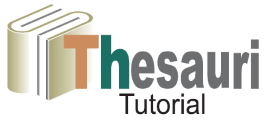Associative relationships exist between terms that are neither related hierarchically nor are equivalent, but are semantically or conceptually associated to such extent that the link between them should be made explicit. The relationship is usually shown with the abbreviation "RT" standing for related term.
The main function of the associative relationship is to suggest additional or alternative terms for indexing or retrieval.
The most basic type of associative relationship is simply related to. As a general rule associative relationships should be made only between terms that are directly related, but where hierarchical and equivalent relationships are inappropriate.
Relationships between terms with overlapping meaning
There may be relationships between overlapping terms where the meanings are similar and can often be used interchangeably in some contexts, but not in others. One such example is the terms "ships" and "boats". These can represent different concepts, and, while they have much in common, neither of them adequately covers the scope of the other. It is therefore essential to assign an associative relationship to them because users might need to use both terms when performing searches in order to find all the relevant material they are looking for.
Other cases of associative linkage
In the cases where one term is strongly implied by another, there are sufficient grounds for associating the two terms. These may include:
- Terms that are intended to be used as separate concepts but may be confused by users.
Example: military bases RT military camps - A discipline or field of study and the objects or phenomena studied.
Example: painting (image making) RT paintings (visual arts) - An operation or process and its agent or instrument.
Example: temperature control RT thermostats - An action and the product or the person performing or receiving the action.
Example: pottery making RT vases, pottery making RT potters - Objects or materials and their properties.
Example: poison RT toxicity - An artefact and its parts, if they do not qualify for the hierarchical whole-part relationship.
Example: optical instruments RT lenses - Concepts linked by causal dependence.
Example: bereavement RT death - An object or process and its counter agent.
Example: insects RT insecticides - A concept and its unit of measurement.
Example: temperature RT Celsius scale - A compound term and the noun that is its focus, if the two do not qualify for the hierarchical relationship.
Example: coprolites RT fossils - An organism or substance bred or derived from another.
Example: brass RT cooper - Antonyms.
Example: high RT low





